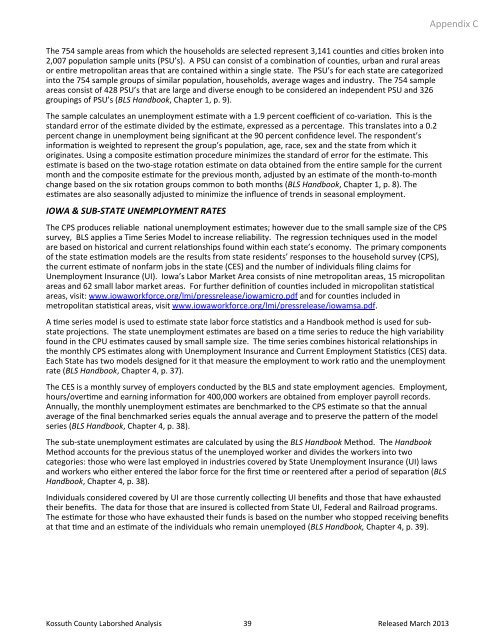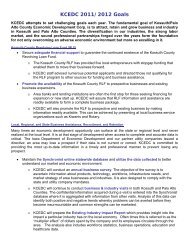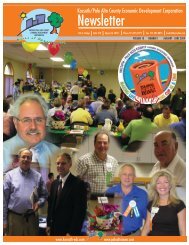Full Report - Kossuth County Economic Development
Full Report - Kossuth County Economic Development
Full Report - Kossuth County Economic Development
Create successful ePaper yourself
Turn your PDF publications into a flip-book with our unique Google optimized e-Paper software.
Appendix CThe 754 sample areas from which the households are selected represent 3,141 counes and cies broken into2,007 populaon sample units (PSU’s). A PSU can consist of a combinaon of counes, urban and rural areasor enre metropolitan areas that are contained within a single state. The PSU’s for each state are categorizedinto the 754 sample groups of similar populaon, households, average wages and industry. The 754 sampleareas consist of 428 PSU’s that are large and diverse enough to be considered an independent PSU and 326groupings of PSU’s (BLS Handbook, Chapter 1, p. 9).The sample calculates an unemployment esmate with a 1.9 percent coefficient of co‐variaon. This is thestandard error of the esmate divided by the esmate, expressed as a percentage. This translates into a 0.2percent change in unemployment being significant at the 90 percent confidence level. The respondent’sinformaon is weighted to represent the group’s populaon, age, race, sex and the state from which itoriginates. Using a composite esmaon procedure minimizes the standard of error for the esmate. Thisesmate is based on the two‐stage rotaon esmate on data obtained from the enre sample for the currentmonth and the composite esmate for the previous month, adjusted by an esmate of the month‐to‐monthchange based on the six rotaon groups common to both months (BLS Handbook, Chapter 1, p. 8). Theesmates are also seasonally adjusted to minimize the influence of trends in seasonal employment.IOWA & SUB‐STATE UNEMPLOYMENT RATESThe CPS produces reliable naonal unemployment esmates; however due to the small sample size of the CPSsurvey, BLS applies a Time Series Model to increase reliability. The regression techniques used in the modelare based on historical and current relaonships found within each state’s economy. The primary componentsof the state esmaon models are the results from state residents’ responses to the household survey (CPS),the current esmate of nonfarm jobs in the state (CES) and the number of individuals filing claims forUnemployment Insurance (UI). Iowa’s Labor Market Area consists of nine metropolitan areas, 15 micropolitanareas and 62 small labor market areas. For further definion of counes included in micropolitan stascalareas, visit: www.iowaworkforce.org/lmi/pressrelease/iowamicro.pdf and for counes included inmetropolitan stascal areas, visit www.iowaworkforce.org/lmi/pressrelease/iowamsa.pdf.A me series model is used to esmate state labor force stascs and a Handbook method is used for substateprojecons. The state unemployment esmates are based on a me series to reduce the high variabilityfound in the CPU esmates caused by small sample size. The me series combines historical relaonships inthe monthly CPS esmates along with Unemployment Insurance and Current Employment Stascs (CES) data.Each State has two models designed for it that measure the employment to work rao and the unemploymentrate (BLS Handbook, Chapter 4, p. 37).The CES is a monthly survey of employers conducted by the BLS and state employment agencies. Employment,hours/overme and earning informaon for 400,000 workers are obtained from employer payroll records.Annually, the monthly unemployment esmates are benchmarked to the CPS esmate so that the annualaverage of the final benchmarked series equals the annual average and to preserve the paern of the modelseries (BLS Handbook, Chapter 4, p. 38).The sub‐state unemployment esmates are calculated by using the BLS Handbook Method. The HandbookMethod accounts for the previous status of the unemployed worker and divides the workers into twocategories: those who were last employed in industries covered by State Unemployment Insurance (UI) lawsand workers who either entered the labor force for the first me or reentered aer a period of separaon (BLSHandbook, Chapter 4, p. 38).Individuals considered covered by UI are those currently collecng UI benefits and those that have exhaustedtheir benefits. The data for those that are insured is collected from State UI, Federal and Railroad programs.The esmate for those who have exhausted their funds is based on the number who stopped receiving benefitsat that me and an esmate of the individuals who remain unemployed (BLS Handbook, Chapter 4, p. 39).<strong>Kossuth</strong> <strong>County</strong> Laborshed Analysis 39 Released March 2013




